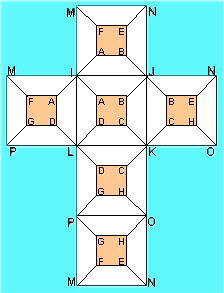The network represents a map of the edges and vertices of a
hypercube or more precisely, a tesseract when imposed within 2D space.
 |
The orange squares represent the faces of the internal cell, a cube in 3D space, and is defined by vertices A to H. The larger bolder letters, I to P are the vertices of the outer cell/cube.
The diagonal lines are the edges which link the inner to the outer forming the faces that configure the cells which interface to the inner and outer cells.
Let each hypercell have a value which is the vertex sum of each of its enclosing faces (or three times the sum of its 8 vertices).
|
The vertices are to be numbered uniquely from 1 to 16, and for consistency of reference, let
A always be 1.
Find sets of values for A through P so that all the cells have the same value.
Note: while the on-line calculator may be useful, a spreadsheet should prove more valuable for those able to use one.
(In reply to
1 solution, program running for remaining by Daniel)
Daniel, that makes for a great solution, 189 for each cell, right?
I entered you values into my on-line "calculator" and wondered why javascript was producing a summation error; Σ 1 to 16 should be 136 but I got 126! I detect that you have b=6 and i=6, but 16 does not appear.
I trust that your counting program does not rely upon the data from which you arrived at this solution.
|
|
Posted by brianjn
on 2009-02-03 01:32:02 |




